Abstract
Several lines of evidence have demonstrated that acute administration of ketamine elicits fast-acting antidepressant effects. Moreover, tramadol also has potential antidepressant effects. The aim of this study was to investigate the effects of pretreatment with tramadol on ketamine-induced antidepressant activity and was to determine the expression of mammalian target of rapamycin (mTOR) in rat hippocampus and prefrontal cortex. Rats were intraperitoneally administrated with ketamine at the dose of 10 mg/kg or saline 1 h before the second episode of the forced swimming test (FST). Tramadol or saline was intraperitoneally pretreated 30 min before the former administration of ketamine or saline. The locomotor activity and the immobility time of FST were both measured. After that, rats were sacrificed to determine the expression of mTOR in hippocampus and prefrontal cortex. Tramadol at the dose of 5 mg/kg administrated alone did not elicit the antidepressant effects. More importantly, pretreatment with tramadol enhanced the ketamine-induced antidepressant effects and upregulated the expression of mTOR in rat hippocampus and prefrontal cortex. Pretreatment with tramadol enhances the ketamine-induced antidepressant effects, which is associated with the increased expression of mTOR in rat hippocampus and prefrontal cortex.
1. Introduction
Mounting studies have demonstrated that ketamine, a widely used anesthetic agent, has antidepressant effects in animal models or patients [1–4]. Compared with conventional antidepressant agents, ketamine exerts fast-acting antidepressant effects within 1-2 h after administration. Moreover, ketamine also has therapeutic effects for patients with treatment-resistant depression [1, 5–9].
Mammalian target of rapamycin (mTOR) is a serine/threonine kinase that modulates the initiation of protein translation, which controls new protein synthesis as required for synaptogenesis [10]. Mounting studies have shown that mTOR plays a critical role in the process of ketamine-exerting antidepressant effects [10, 11]. A recent study has indicated that ketamine's antidepressant effects are associated with the upregulation of mTOR in prefrontal cortex [12], which is confirmed by a subsequent case report with an increase of mTOR in the peripheral blood in a depressed patient [13]. Moreover, Jernigan et al. [14] have detected decreased mTOR expression in depressed patients' brain in the postmortem study. These findings indicate that mTOR acts as a crticical role in the pathogenesis of depression.
On the other hand, tramadol is a widely used analgesic agent, which exerts therapeutic effects via activation of opioid receptors and elevating the plasma levels of serotonin and norepinephrine [15]. As we know, the most prescribed conventional antidepressant agents produce their efficacy also through increasing the monoamine levels, which share the identical mechanisms as tramadol. From this point of view, we thus suggested that tramadol also has potential to exert antidepressant effects.
However, there is no information available at present regarding the effects of pretreatment with tramadol on the ketamine-induced antidepressant activity. Therefore, this study aimed to evaluate the effects of tramadol pretreatment on ketamine-induced antidepressant activity and to determine the expression of mTOR in rat hippocampus and prefrontal cortex.
2. Materials and Methods
2.1. Animals
Eighty-six male Wistar rats weighing 180–220 g were purchased from Shanghai Animal Center, Shanghai, China. The rats were housed 5 per cage with food and water available ad libitum and were maintained on a 12 h light/dark cycle (lights on at 7:00 am). Animals were involved in this experiment in accordance with the Guide for Care and Use of Laboratory Animals of National Institutes of Health.
2.2. Drugs and Treatment
Ketamine was obtained from Gutian Pharmaceutical Company (Fujian, China). Tramadol was purchased from Grunenthal GmbH (Germany). One day before drug pretreatment, rats were involved in the FST for 15 min as pretest session. At the day of drug pretreatment, rats were intraperitoneally injected with tramadol at the dose of 5 mg/kg or saline, respectively. Thirty minutes later, rats were intraperitoneally injected with ketamine at the dose of 10 mg/kg or saline 1 h before the second episode of the FST, respectively. Another 30 min later, FST was conducted for 5 min as test session, and the immobility time was recorded. All the interventions were administrated in the same volume of 1 mL.
2.3. Open-Field Tests
Locomotor activity of rats was evaluated by using open-field tests, which were performed during light phase of the light-dark cycle. The open-field consisted of an arena of 100 × 100 cm square floor surrounded by 30 cm high wall. The floor of the arena was divided into 25 equal squares. Thirty minutes later after the drug or saline intervention, rats were placed in the center of the square, and the numbers of crossings and rearings were subsequently recorded [16].
2.4. Forced Swimming Test (FST)
The FST included two separate exposures to a cylindrical tank with water in which rats cannot touch the bottom of the tank. The volume of the tank was 60 cm tall, 30 cm in diameter, and was filled with water in a depth of 40 cm. All the procedures were conducted between 9:00–15:00. Rats were placed in the water for 15 min without any administration. Twenty-four hours later, rats were treated as the first episode lasting 5 min, and the immobility time of rats was recorded. Rats were intraperitoneally administrated with intervents in the same volume at 30 min before the second episode of the FST. Each rat was judged to be immobile when it ceased struggling and remained floating motionless in the water, making only those movements necessary to keep its head above water. Immobility time was recorded by the same observer. Water in the tank was changed after the test of every rat.
2.5. Western Blotting
Immediately after the FST, the rats were sacrificed by decapitation, and the hippocampus and prefrontal cortex were rapidly dissected out on an ice-cold plate, frozen, and stored at −80°C until used. Samples of homogenates (15 μg of protein) were subjected to SDS-PAGE under reducing conditions. Proteins were transferred onto PDVF membranes, and the stripped blots were kept blocking solution for 1 hr and incubated with the antiphospho mTOR Ser 2448 (1 : 2000, Cell Signaling) directed against total levels of the mTOR (1 : 2000, Cell Signaling) for loading control. Densitometric analysis of immunoreactivity for each protein was conducted using Image J software.
2.6. Statistical Analysis
Statistical analysis was performed by Statistical Product for the Social Sciences (SPSS version 17.0). Data are expressed as mean ± standard deviation (SD). Comparisons were made by one-way analysis of variance (ANOVA) and post hoc comparisons were performed by the least significant difference tests. Differences were considered to be significant at P < 0.05.
3. Results
Different doses of tramadol were intraperitoneally injected to investigate its antidepressant effects. Rats showed a significant decrease in the immobility time during the FST after the administration of tramadol at the dose of 10 mg/kg (Figure 1, P < 0.05). However, tramadol at the doses of 2.5 and 5 mg/kg both did not elicit any changes of the immobility time as compared with saline-treated rats (Figure 1, P > 0.05).
Figure 1.
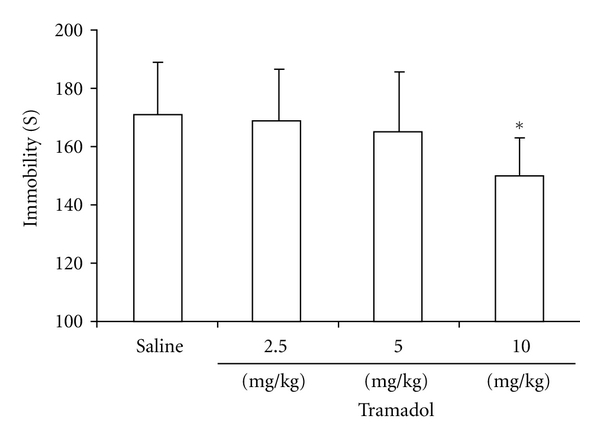
Immobility time of rats (n = 10) during the FST after intraperitoneal injection of tramadol at different doses. Tramadol administered at the dose of 10 mg/kg significantly decreased the immobility time as compared to saline (*P < 0.05), while tramadol administered at the doses of 2.5 and 5 mg/kg both did not affect the immobility time (P > 0.05).
Before the FST, open-field test was required to test whether locomotor activities were affected in the experimental rats. Compared with saline-treated rats, treatment with ketamine at the dose of 10 mg/kg did not induce any significant changes of crossings and rearings of rats in the open-field test (Figure 2(a), P > 0.05). Moreover, tramadol pretreatment also did not change the crossings and rearings of ketamine-treated rats as compared with saline (Figure 2(b), P > 0.05).
Figure 2.
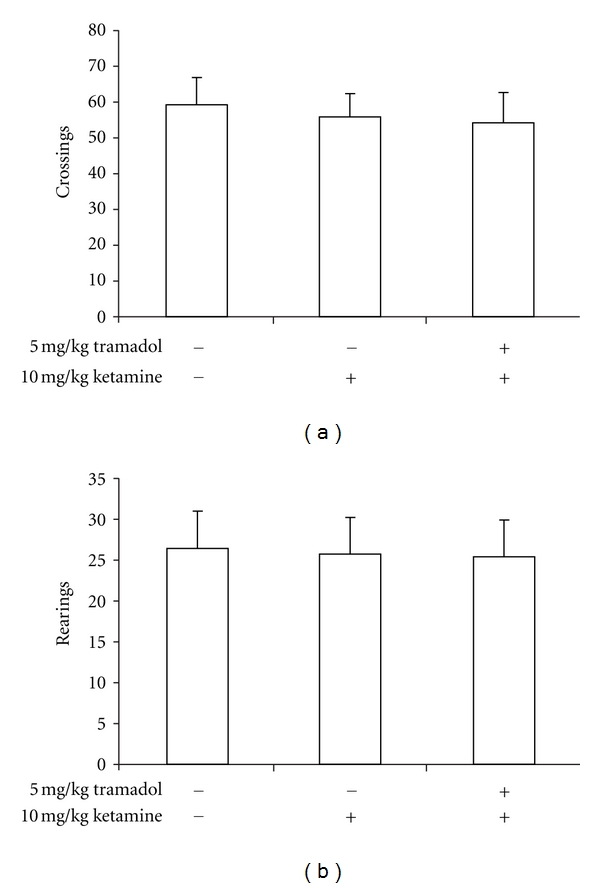
(a) The scores of crossings of rats (n = 10) during open-field tests. Ketamine administered at the dose of 10 mg/kg did not affect the scores of crossings, and pretreatment with 5 mg/kg tramadol did not affect any changes of scores of crossings (P > 0.05). (b) The scores of rearings of rats (n = 10) during open-field tests. Ketamine administered at the dose of 10 mg/kg did not affect the scores of rearings, and pretreatment with 5 mg/kg tramadol did not affect any changes of scores of rearings (P > 0.05).
Ketamine-treated rats showed a significant decrease in immobility time during the FST as compared with saline (Figure 3, P < 0.05), and pretreatment with tramadol at the dose of 5 mg/kg further decreased immobility time of rats in the FST as compared with ketamine-treated alone (Figure 3, P < 0.05).
Figure 3.
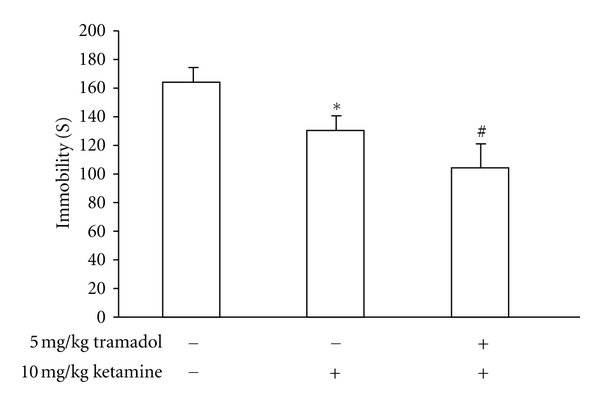
The immobility time of rats (n = 10) during the FST after intraperitoneal injection of ketamine and pretreatment with tramadol. Ketamine administered at the dose of 10 mg/kg significantly decreased the immobility time as compared with control (*P < 0.05), and pretreatment with 5 mg/kg tramadol significantly decreased the immobility time as compared with ketamine administration (#P < 0.05).
Compared with saline-treated rats, the administration of ketamine at the dose of 10 mg/kg significantly increased the levels of mTOR in rat hippocampus (Figure 4, P < 0.05), and pretreatment with tramadol at the dose of 5 mg/kg increased the levels of mTOR as compared with ketamine-treated rats (Figure 4, P < 0.05).
Figure 4.
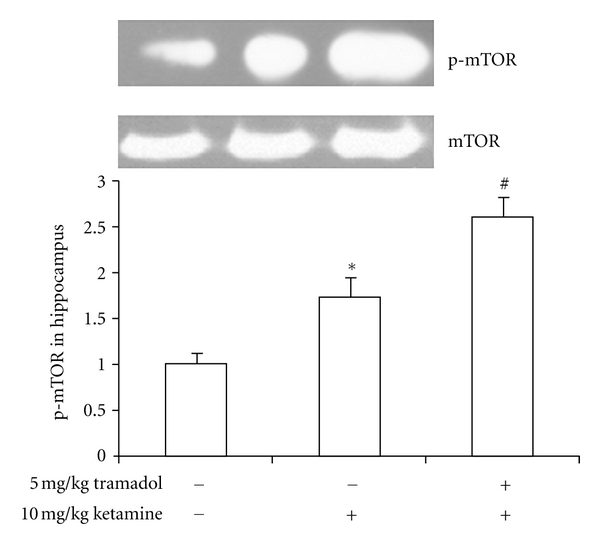
The expression of p-mTOR in rat hippocampus (n = 3). Ketamine administered at the 10 mg/kg significantly increased the expression of p-mTOR in rat hippocampus as compared with control (*P < 0.05), and tramadol pretreated at the dose of 5 mg/kg significantly increased the expression of p-mTOR as compared with ketamine administered alone (#P < 0.05).
Compared with saline-treated rats, the administration of ketamine at the dose of 10 mg/kg significantly increased the levels of mTOR in rat prefrontal cortex (Figure 5, P < 0.05), and pretreatment with tramadol at the dose of 5 mg/kg increased the levels of mTOR in rat prefrontal cortex as compared with ketamine-treated rats (Figure 5, P < 0.05).
Figure 5.
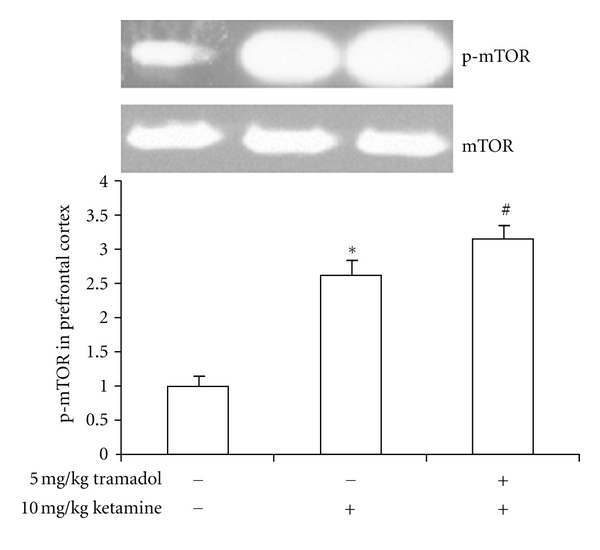
The expression of p-mTOR in rat prefrontal cortex (n = 3). Ketamine administered at the 10 mg/kg significantly increased the expression of p-mTOR in rat prefrontal cortex as compared with control (*P < 0.05), and tramadol pretreated at the dose of 5 mg/kg significantly increased the expression of p-mTOR as compared with ketamine administered alone (#P < 0.05).
4. Discussion
The FST is a widely used behavioral test in rodents, which is sensitive and selective for clinically effective antidepressant agents [17]. In this study, the results showed that ketamine significantly decreased the immobility time of rats during the FST, suggesting that ketamine has exact antidepressant effects. More importantly, this study demonstrated that tramadol administrated alone at the dose of 10 mg/kg could elicit significant decrease in immobility time of rats during the FST, and our findings also showed that tramadol under the dose of 10 mg/kg did not induce a significant change of immobility time. Therefore, we administrated tramadol at the dose of 5 mg/kg in this study to avoid its potential antidepressant effects. Interestingly, although administration of tramadol at the dose of 5 mg/kg could not elicit any antidepressant effects, pretreatment with it could enhance ketamine-indued antidepressant effects. However, the exact mechanisms of pretreatment with tramadol-enhancing ketamine-induced antidepressant effects are unclear.
A previous study shows that ketamine suppresses the serotonin transporter and norepinephrine transporter in cultured human embryonic kidney 293 cells [18]. Moreover, Reeves and Burke [19] demonstrated that the increase of serotonin and norepinephrine neurotransmitter is the core mechanism of tramadol exerting its efficacy. Thus ketamine and tramadol may have synergistic effects to elevate the serotonin and norepinephrine levels in central nervous system, which then lead to the enhanced antidepressant effects.
Wang et al. [20] have shown that propofol, an anesthetic agent, administered alone does not elicit antidepressant effects, but may enhance ketamine-induced antidepressant effects. Réus et al. [21] have observed that the coadministration of ketamine and imipramine produces the enhanced antidepressant effects, and the authors attribute the underlying mechanisms of enhanced ketamine-induced antidepressant effects to the increased expression of glutamate-α-amino-3-hydroxy-5-methyl-4-isoxazolepropionic acid receptor-1 in rat hippocampus, cyclic adenosine monophosphate response element-binding and brain-derived neurotrophic factor protein levels, and protein kinase C and protein kinase A phosphorylation in rat brain, respectively. Interestingly, our study showed that pretreatment with tramadol-enhancing ketamine-induced antidepressant effects was associated with the increased expression of mTOR in rat hippocampus and prefrontal cortex.
As above mentioned, ketamine's antidepressant effects are mainly due to the upregulation of mTOR in rat prefrontal cortex, and the activation of mTOR can stimulate the synaptogenesis [12]. The induction of mTOR signaling occurs within 30 min after ketamine administration [10]. Collectively, these findings suggest that ketamine's antidepressant effects are associated with mTOR-dependent synaptogenesis in rat prefrontal cortex. Our findings exhibited an enhanced expression of mTOR in rat hippocampus and prefrontal cortex after pretreatment with tramadol. Until now, no data has shown that tramadol has effects on the expression of mTOR or synaptogenesis. So we supposed that tramadol has effects on stimulation of synaptogenesis via activating mTOR, which may contribute to the underlying mechanism of tramadol-enhancing ketamine-induced antidepressant effects.
In Conclusion, Ketamine exerts exactly antidepressant effects in rats during the FST, and tramadol pretreatment enhances its antidepressant effects. The relevant mechanisms are potentially ascribed to the activation of mTOR in rat hippocampus and prefrontal cortex. However, we did not evaluate whether tramadol-pretreatment-enhancing ketamine-induced antidepressant effects are related to synaptogenesis in rat hippocampus, and further studies are needed to understand the exact relevant mechanisms.
Acknowledgments
This work was supported by grants from the National Natural Science Foundation of China (Grant no. 30872424).
References
- 1.Diazgranados N, Ibrahim L, Brutsche NE, et al. A randomized add-on trial of an N-methyl-D-aspartate antagonist in treatment-resistant bipolar depression. Archives of General Psychiatry. 2010;67(8):793–802. doi: 10.1001/archgenpsychiatry.2010.90. [DOI] [PMC free article] [PubMed] [Google Scholar]
- 2.Machado-Vieira R, Salvadore G, DiazGranados N, Zarate CA., Jr Ketamine and the next generation of antidepressants with a rapid onset of action. Pharmacology and Therapeutics. 2009;123(2):143–150. doi: 10.1016/j.pharmthera.2009.02.010. [DOI] [PMC free article] [PubMed] [Google Scholar]
- 3.Skolnick P, Popik P, Trullas R. Glutamate-based antidepressants: 20 years on. Trends in Pharmacological Sciences. 2009;30(11):563–569. doi: 10.1016/j.tips.2009.09.002. [DOI] [PubMed] [Google Scholar]
- 4.Zarate CA, Jr, Singh JB, Carlson PJ, et al. A randomized trial of an N-methyl-D-aspartate antagonist in treatment-resistant major depression. Archives of General Psychiatry. 2006;63(8):856–864. doi: 10.1001/archpsyc.63.8.856. [DOI] [PubMed] [Google Scholar]
- 5.aan het Rot M, Collins KA, Murrough JW, et al. Safety and efficacy of repeated-dose intravenous ketamine for treatment-resistant depression. Biological Psychiatry. 2010;67(2):139–145. doi: 10.1016/j.biopsych.2009.08.038. [DOI] [PubMed] [Google Scholar]
- 6.DiazGranados N, Ibrahim LA, Brutsche NE, et al. Rapid resolution of suicidal ideation after a single infusion of an N-methyl-D-aspartate antagonist in patients with treatment-resistant major depressive disorder. Journal of Clinical Psychiatry. 2010;71(12):1605–1611. doi: 10.4088/JCP.09m05327blu. [DOI] [PMC free article] [PubMed] [Google Scholar]
- 7.Liebrenz M, Borgeat A, Leisinger R, Stohler R. Intravenous ketamine therapy in a patient with a treatment-resistant major depression. Swiss Medical Weekly. 2007;137(15-16):234–236. doi: 10.4414/smw.2007.11852. [DOI] [PubMed] [Google Scholar]
- 8.Zarate C, Jr, MacHado-Vieira R, Henter I, Ibrahim L, Diazgranados N, Salvadore G. Glutamatergic modulators: the future of treating mood disorders. Harvard Review of Psychiatry. 2010;18(5):293–303. doi: 10.3109/10673229.2010.511059. [DOI] [PMC free article] [PubMed] [Google Scholar]
- 9.Price RB, Nock MK, Charney DS, Mathew SJ. Effects of intravenous ketamine on explicit and implicit measures of suicidality in treatment-resistant depression. Biological Psychiatry. 2009;66(5):522–526. doi: 10.1016/j.biopsych.2009.04.029. [DOI] [PMC free article] [PubMed] [Google Scholar]
- 10.Duman RS, Li N, Liu R-J, Duric V, Aghajanian G. Signaling pathways underlying the rapid antidepressant actions of ketamine. Neuropharmacology. 2012;62(1):35–41. doi: 10.1016/j.neuropharm.2011.08.044. [DOI] [PMC free article] [PubMed] [Google Scholar]
- 11.Hashimoto K. Role of the mTOR signaling pathway in the rapid antidepressant action of ketamine. Expert Review of Neurotherapeutics. 2011;11(1):33–36. doi: 10.1586/ern.10.176. [DOI] [PubMed] [Google Scholar]
- 12.Li N, Lee B, Liu RJ, et al. mTOR-dependent synapse formation underlies the rapid antidepressant effects of NMDA antagonists. Science. 2010;329(5994):959–964. doi: 10.1126/science.1190287. [DOI] [PMC free article] [PubMed] [Google Scholar]
- 13.Denk MC, Rewerts C, Holsboer F, Erhardt-Lehmann A, Turck CW. Monitoring ketamine treatment response in a depressed patient via peripheral mammalian target of rapamycin activation. American Journal of Psychiatry. 2011;168(7):751–752. doi: 10.1176/appi.ajp.2011.11010128. [DOI] [PubMed] [Google Scholar]
- 14.Jernigan CS, Goswami DB, Austin MC, et al. The mTOR signaling pathway in the prefrontal cortex is compromised in major depressive disorder. Progress in Neuro-Psychopharmacology and Biological Psychiatry. 2011;35(7):1774–1779. doi: 10.1016/j.pnpbp.2011.05.010. [DOI] [PMC free article] [PubMed] [Google Scholar]
- 15.Barber J. Examining the Use of Tramadol Hydrochloride as an Antidepressant. Experimental and Clinical Psychopharmacology. 2011;19(2):123–130. doi: 10.1037/a0022721. [DOI] [PubMed] [Google Scholar]
- 16.de Lima MNM, Laranja DC, Caldana F, et al. Selegiline protects against recognition memory impairment induced by neonatal iron treatment. Experimental Neurology. 2005;196(1):177–183. doi: 10.1016/j.expneurol.2005.07.017. [DOI] [PubMed] [Google Scholar]
- 17.Detke MJ, Johnson J, Lucki I. Acute and chronic antidepressant drug treatment in the rat forced swimming test model of depression. Experimental and Clinical Psychopharmacology. 1997;5(2):107–112. doi: 10.1037//1064-1297.5.2.107. [DOI] [PubMed] [Google Scholar]
- 18.Nishimura M, Sato K, Okada T, et al. Ketamine inhibits monoamine transporters expressed in human embryonic kidney 293 cells. Anesthesiology. 1998;88(3):768–774. doi: 10.1097/00000542-199803000-00029. [DOI] [PubMed] [Google Scholar]
- 19.Reeves RR, Burke RS. Tramadol: basic pharmacology and emerging concepts. Drugs of Today. 2008;44(11):827–836. doi: 10.1358/dot.2008.44.11.1289441. [DOI] [PubMed] [Google Scholar]
- 20.Wang X, Yang Y, Zhou X, et al. Propofol pretreatment increases antidepressant-like effects induced by acute administration of ketamine in rats receiving forced swimming test. Psychiatry Research. 2011;185(1-2):248–253. doi: 10.1016/j.psychres.2010.04.046. [DOI] [PubMed] [Google Scholar]
- 21.Réus GZ, Stringari RB, Ribeiro KF, et al. Ketamine plus imipramine treatment induces antidepressant-like behavior and increases CREB and BDNF protein levels and PKA and PKC phosphorylation in rat brain. Behavioural Brain Research. 2011;221(1):166–171. doi: 10.1016/j.bbr.2011.02.024. [DOI] [PubMed] [Google Scholar]


